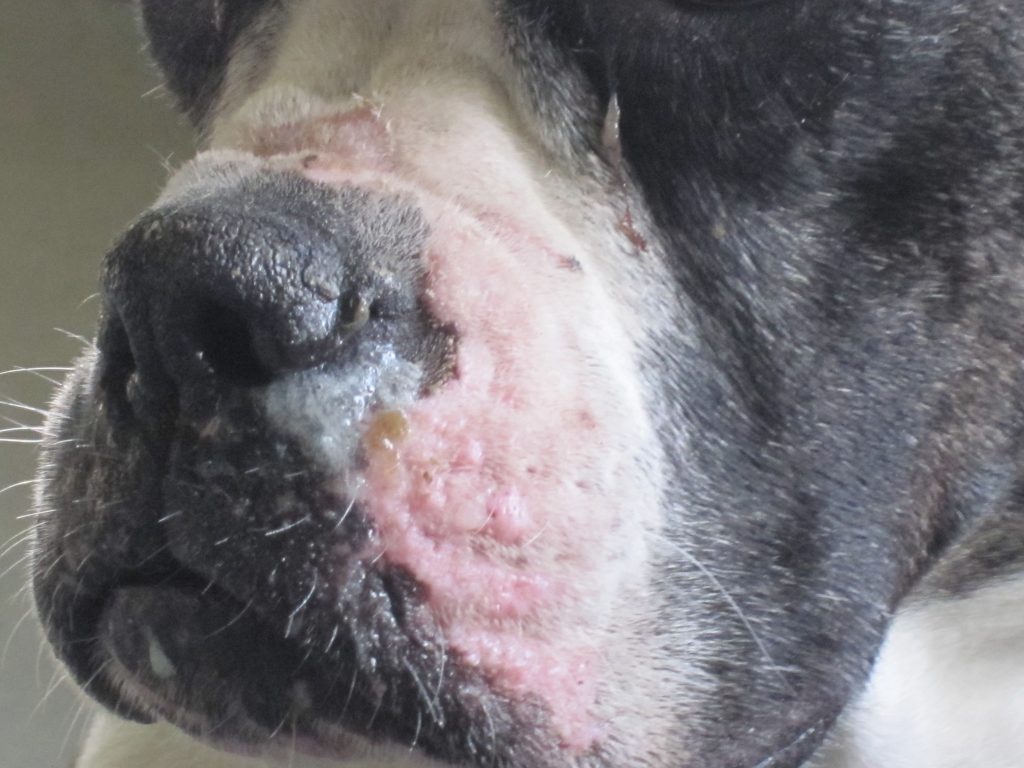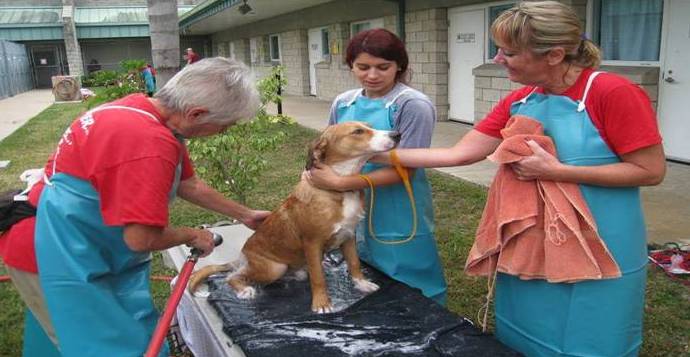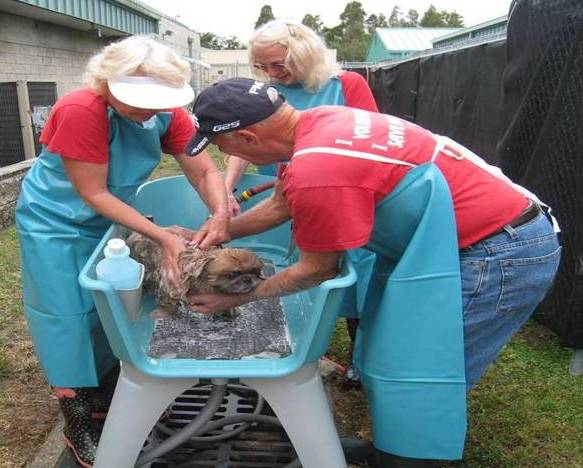Module 4: Healthcare practices for common contagious infectious diseases
Estimated Reading and Video Viewing Time: 5.5 hrs
It’s a Friday…
It’s Friday morning at Gatorland Animal Services. The vet tech has just finished the Daily Medical Rounds and reports to Dr. Wright that a lot of dogs are sneezing and coughing. The tech said she saw clear nasal discharge in some dogs earlier in the week but thought it was due to the recent cold weather. Now many dogs have yellow nasal discharge and coughing. Volunteers have arrived and are bathing all the dogs in preparation for the big adoption event tomorrow.
- Group of volunteers bathing a dog at Gatorland Animal Services
- Another group of volunteers
The tech pleaded with Dr. Wright: “Geez Doc – we’ve got this big event tomorrow and we’re a bit crowded with dogs. This is a “Clear the Shelter” fee-waived adoption so most of them can go to homes. Maybe this is just a little cold that’s no big deal and we can still adopt out the dogs tomorrow?”
Dr. Wright and the vet tech walked to the dog kennel to count the number of dogs with and without clinical signs. Of the 65 dogs, 13 (20%) had clear or mucopurulent nasal discharge and coughing. With this number of dogs affected in a short time, Dr. Wright knew the infection was contagious and more dogs likely would become sick.
Watch This
This is a video of one of the dogs at Gatorland Animal Services (0:09). [No audio commentary. The dog is coughing and dogs are barking in the background.]

What do you think? What should Dr. Wright do about the adoption event? What are her next steps? What would happen if Dr. Wright was not at the shelter this Friday morning?
Just like for the medical conditions discussed in Module 3, the shelter veterinarian should create and supervise SOPs for common contagious diseases. Staff needs to know what to do in the absence of a veterinarian: Can they identify signs of disease? Do they know where to house sick animals? Do they know who to call or what diagnostic tests and treatments are authorized to start before the shelter veterinarian is available?
ASV Guidelines Statement on Veterinary Supervision in Animal Shelters
- Providing treatment for common medical conditions by trained shelter staff may occur under indirect supervision as long as tasks are in compliance with a written protocol developed in consultation with the veterinarian. For example, treatment of individual or large groups of animals for an infectious condition may be performed under telephonic or written instruction from the veterinarian.
- Indirect supervision means a licensed veterinarian need not be on the premises; has given either written or oral instructions for treatment of the patient; is readily available by telephone or other forms of immediate communication; and has assumed responsibility for the veterinary care given to the patient by a person working under his or her direction.
Review the Responding to Infectious Disease section in Chapter 6 of the 2022 ASV Guidelines.
ASV Guidelines Response to Disease and Illness
- Response to disease and illness is an integral part of the shelter health program.
- A disease response plan includes measures to minimize transmission to unaffected animals or people and ensures appropriate care of the affected animal.
- Protocols to define and manage common clinical illnesses based on clinical signs are developed and used in consultation with a veterinarian.
- Protocols detail the expected course of the disease and response to treatment and veterinary input is sought when disease or response to treatment does not follow the expected course.
- Treatment decisions are based on a number of criteria, including the ability to safely and humanely provide relief, duration of treatment, prognosis for recovery, the likelihood of placement after treatment, the number of animals who must be treated and the expense and resources available.
- Animals with a suspected contagious infectious disease are isolated until diagnosis or subsequent treatment determines them to be a low risk to the general population.
- Even animals with mild clinical signs of contagious disease should not be housed in the general population.
- Leaving animals with severe infectious disease in the general population is unacceptable.
- Initially, a clinical or working diagnosis determined by a veterinarian may provide the basis for treatment and response.
- Diagnosis or identification of specific pathogens should be sought when the number of cases increases above typical for the shelter, when signs are severe or not responding to treatment as expected, and when a zoonotic condition is suspected.
In this module, we review the Top 5 contagious diseases that commonly affect shelter dogs and cats, including canine and feline respiratory infections, canine and feline parvovirus, and ringworm. Pay close attention to the properties of the pathogens as these affect diagnostic testing and treatment as well as practices that mitigate spread of disease.



